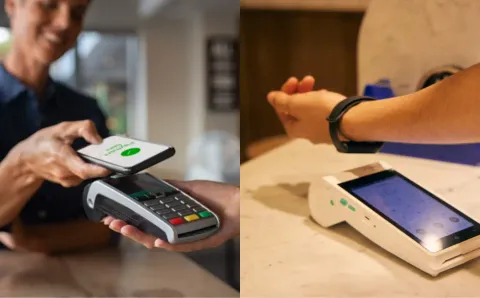You tap your phone. Payment done. No card, no contact. That’s NFC (Near Field Communication), the tech that powers contactless payments. It’s already everywhere…from your phone to the POS terminal at your local store. Mobile wallets like Apple Pay and Google Pay depend on it. So do smart businesses that want faster, cleaner checkouts.
This guide explains what NFC really is, how it works in mobile payments, and why it’s changing how we all pay and get paid.
How NFC Actually Works When You Tap to Pay

You’ve probably seen someone tap their phone to pay for coffee…or maybe you’ve done it yourself. But have you ever wondered how it works? That tap relies on a short-range wireless technology called NFC, which stands for Near Field Communication.
NFC allows two devices to connect and share information when they’re really close—within about 4 centimeters. It’s fast, reliable, and doesn’t need an internet connection.
The Tap Happens Through Short-Range Signals
When you tap your phone or card at a payment terminal, your device sends a signal using radio waves. Your phone (or contactless card) has a built-in NFC chip. The terminal detects that signal, reads the payment information, and processes the transaction, usually in under a second.
This exchange is quick, wireless, and doesn’t require your card to have a battery. That’s why tap-to-pay works even if your card seems passive.
How NFC Is Different From RFID
NFC is actually a type of RFID technology, which is used to track objects, like boxes in a warehouse or inventory in stores. But there’s a big difference.
RFID usually sends information one way, from a tag to a reader. NFC, on the other hand, allows two-way communication. That makes it much more helpful for secure tasks, like mobile payments, unlocking doors, or sharing contact info.
Common Places You Use NFC Without Noticing
You already use NFC more than you think. It powers mobile wallets like Apple Pay and Google Pay. It’s also in transit cards, hotel keycards, and smart tags that open links or apps when you scan them.
Businesses use it for quick check-ins, contactless access, and fast checkouts.
How Mobile Payments Work With NFC
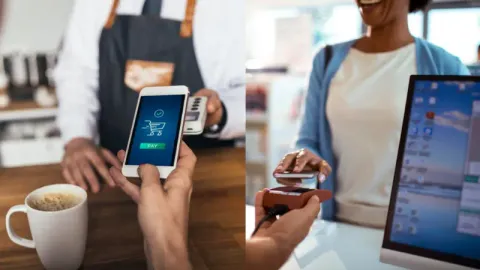
Instead of carrying cards or cash, you can use your phone to make payments. NFC mobile payments offer a faster, safer, and more convenient way to check out in everyday situations.
Paying With a Phone Instead of a Card
NFC mobile payments let you pay by tapping your smartphone against a contactless terminal…just like you would with a contactless card.
However, your phone gives you more control over the transaction and doesn’t require any physical contact.
Popular Apps That Power the Tap
Most modern smartphones have built-in NFC chips, which mobile wallet apps like Apple Pay, Google Pay, and Samsung Pay put to work.
When you add your card to one of these apps, your phone creates a secure digital version. During payment, it sends the information wirelessly and safely to the terminal.
Where People Use NFC Payments Daily
You’ll see NFC payment options almost everywhere…stores, vending machines, public transit, and even taxis.
Many fast food chains and retailers support tap-to-pay, and major city transit systems let you tap your phone instead of using a card or ticket.
Some taxis also accept phone payments, making it easier to pay without needing cash or swiping a card.
Built-In Security That Protects Each Payment
To keep your information safe, NFC payments use tokenization, which means your actual card number isn’t shared during the transaction. Instead, the system creates a one-time code that works only for that payment.
Most phones also require biometric security…like Face ID or a fingerprint. It protects your money even if your phone is lost or stolen.
How NFC Mobile Payments Work: Step-by-Step Process
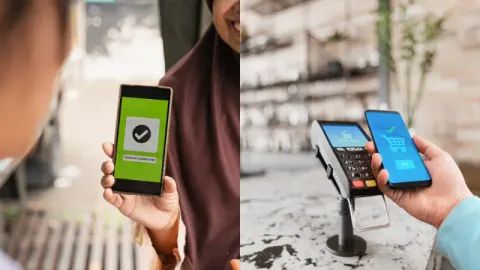
Whether you’re tapping to buy a coffee or accepting payments at the counter, NFC follows the same quick and secure process. Here’s how it works on both ends:
Step 1: The user adds the card to the mobile wallet
Users load their debit or credit card into a wallet app like Apple Pay, Google Pay, or Samsung Pay. The bank verifies the card and connects it to the app securely.
Step 2: The user selects a payment method
At checkout, the user opens the wallet app and selects a card. This tells the phone which account to use.
Step 3: Biometric security confirms identity
A fingerprint or face ID confirms the transaction. This protects users and keeps businesses safe from fraud.
Step 4: The tap triggers the data exchange
Holding the phone close to the terminal—usually within 4 cm—activates the NFC connection and starts the contactless payment.
Step 5: A token replaces the card number
Instead of sending the actual card number, the phone sends a unique, one-time-use code called a token. This keeps personal financial data protected.
Step 6: The bank approves or declines instantly
The payment terminal sends the token to the bank, which quickly approves or declines the transaction based on the account status.
Step 7: Both sides get confirmation
The customer sees a checkmark, hears a beep, or feels a vibration. The business receives instant approval and finishes the sale.
This entire process takes just a few seconds…but it adds up to fast, secure payments for customers and safer transactions for businesses.
NFC Tags and What They Can Do Beyond Payments
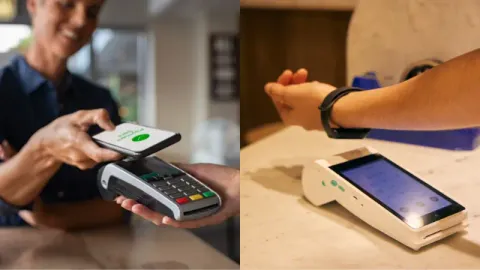
An NFC tag is a small chip that stores a tiny bit of data. You can tap it with a phone to trigger a task, open a link, or share information.
They’re called passive tags because they don’t need a battery…they draw the small amount of energy needed from the phone or reader that scans them.
Passive vs Active Tags
- Passive tags don’t have batteries. They only send data when scanned by a phone or reader.
- Active tags have a power source. They can send signals on their own, like for tracking or broadcasting.
Where NFC Tags Show Up in Real Life
Although most people associate NFC with tap-to-pay, these tags have a wide range of practical uses beyond payments. Businesses and tech enthusiasts widely use them to streamline daily tasks or improve customer interaction.
- Digital business cards allow you to transfer contact information directly to someone’s phone with a quick tap.
- Loyalty check-ins let customers tap their phones at specific locations to earn points or rewards. It creates a seamless and interactive experience.
- Phone automation is another creative use: you can program a tag to adjust your phone’s settings, connect to Wi-Fi, or open specific apps depending on where you are.
- Smart posters can launch a website, show event details, or unlock a special offer when tapped.
They’re cheap, easy to program, and work well in high-traffic settings. Whether you’re a business owner or a tech-savvy shopper, NFC tags offer a quick way to connect digital actions with the real world.
NFC Payment Terminals and How They Work for Businesses
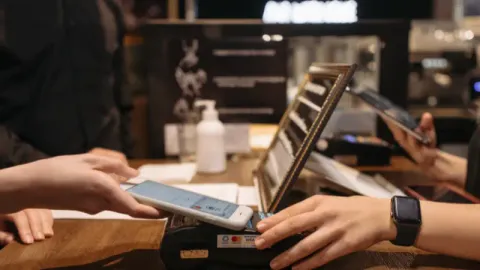
NFC payment terminals have become the new normal at checkout. They let customers tap their phones, cards, or wearables to pay in seconds.
For businesses, this means faster lines, fewer touchpoints, and better customer flow.
Devices That Accept Tap Payments
An NFC payment terminal (also called NFC POS) reads payment data from:
- Mobile wallets like Apple Pay, Google Pay, Samsung Pay
- Contactless credit and debit cards
- Wearable devices with payment features
These terminals work with short-range wireless tech. The customer simply holds the device near the reader…no swiping or inserting is needed.
Where You’ll See These Terminals in Use
NFC-ready POS systems are standard in:
- Retail stores – clothing, grocery, convenience
- Restaurants – table-side or counter-payments
- Vending machines – tap to buy drinks or snacks
- Transit systems – buses, trains, metro gates
- Self-serve kiosks – parking machines, ticket machines
They’re fast, hands-free, and fit into busy environments.
NFC Terminals vs Traditional Card Machines
Here’s how NFC compares to older swipe-and-chip machines:
| Feature | NFC Terminal | Traditional POS |
|---|---|---|
| Setup | Wireless, compact | Wired, bulky |
| Speed of Transaction | Under 2 seconds | Slower with PINs or chip read |
| Contact Required | No | Yes (swipe, insert) |
| Customer Experience | Seamless, fast | Often slower, more steps |
| Cost | Slightly higher upfront | Lower initial setup |
If you’re running a store or service counter, switching to NFC makes checkout smoother. It’s faster for customers and easier for staff.
It also opens the door to mobile payments and loyalty integrations.
Why More Businesses Are Moving to NFC Payments
NFC payments have shifted from being a modern convenience to a customer expectation.
Consumers and businesses are embracing contactless transactions because of the growing demand for speed.

Why Customers Prefer It
- Faster checkout – Transactions are completed in just seconds with a quick tap.
- No physical wallet required – Phones and smartwatches handle payments on the go.
- Improved hygiene – There’s no need to touch buttons or exchange cards.
- Built-in security – Digital wallets use encryption and biometrics to protect your information.
Customers are drawn to payment methods that combine ease, speed, and safety—and NFC delivers all three without added effort.
Why It Makes Sense for Your Business
- Faster service – Speeding up checkout allows you to assist more customers in less time.
- Widespread adoption – Many people already use platforms like Apple Pay and Google Pay.
- Reduced hardware wear – With less physical contact, payment terminals last longer.
- Modern appeal – Accepting tap-to-pay shows customers your business is up-to-date with technology.
Whether you manage a restaurant, a retail shop, or a service desk, offering NFC payment options helps you create a smoother, more professional customer experience. As digital habits continue to evolve, adapting to NFC is a practical and forward-thinking decision.
Whether you run a retail store, restaurant, or service counter, NFC payments streamline operations and leave a better impression. It’s a smart move with long-term value.
Devices and Hardware That Power NFC Payment
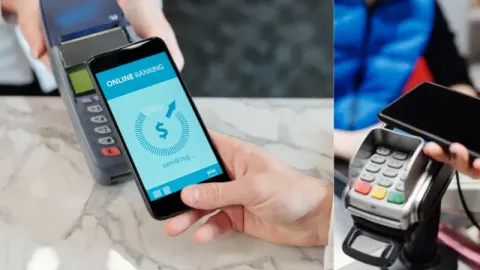
Consumer devices
Most NFC payments happen through smartphones.
Almost all iPhones since the iPhone 6 and most Android models come with built-in NFC. Smartwatches like the Apple Watch and Samsung Galaxy Watch also support tap-to-pay.
Some tablets, mainly for business use, include NFC chips as well.
If a device supports mobile wallet apps and has NFC, it can handle contactless payments in stores, taxis, and vending machines.
Popular mobile wallets
According to business(.)com review, Apple Pay, Google Pay, and Samsung Pay are the most used NFC payment apps. These wallets store your card details securely and let you pay with a simple tap.
Apple Pay works only on Apple devices. Google Pay and Samsung Pay work on most Android phones.
These apps often use biometric checks like Face ID or fingerprints for fast and secure approval before payment goes through.
Business hardware
Businesses need NFC-ready payment terminals. Most modern POS systems…especially those built for Android or iOS, support NFC by default.
You can also use compact NFC card readers that plug into tablets or smartphones. These tools read the tap from the customer’s device, verify the transaction, and complete it in seconds.
Even small businesses can get started with portable readers that connect via Bluetooth or USB.
Cloud-connected POS systems with NFC
Modern POS systems connect to the cloud. That means businesses can track sales in real-time, update pricing remotely, and sync across locations.
These systems often come with built-in NFC modules, so no extra hardware is needed. For businesses that want speed, mobility, and smart data access, cloud-connected NFC POS setups offer a complete, modern solution.
How NFC Compares to QR Codes and RFID
Each contactless tech works differently.
NFC, QR codes, and RFID all allow data exchange without swiping or plugging in. But their speed, range, and setup needs vary.
Here’s how each one stacks up:
| Feature | NFC | QR Code | RFID |
|---|---|---|---|
| Range | ~4cm | Visual scan | Up to several meters |
| Speed | Instant | Slower | Fast |
| Hardware | Phone + NFC | Camera | RFID reader |
| Use Cases | Payments, access cards | Menus, links | Warehousing, logistics |
When to Use Each Technology
Each of these technologies serves a different purpose. The best one depends on your environment and goals.

When Should You Use NFC?
NFC is ideal when speed and security matter. Mobile payments, tap-to-enter transit systems, and smart hotel keycards all benefit from its short-range and real-time response.
It needs NFC-capable devices but works seamlessly once set up.
When is the QR Code Best?
QR codes shine in casual, camera-based situations. They’re perfect for restaurants, pop-up events, or product packaging where scanning a code leads to a link or menu.
The setup is simple, but scanning takes a bit longer and can feel clunky in low light or with damaged prints.
When is RFID ideal?
RFID covers long-range needs. It’s widely used in logistics and asset tracking, where scanning items one by one isn’t practical.
RFID requires special readers and tags, making it more suited to industrial use than consumer-facing transactions.
Why NFC Is the Go-To for Mobile Payments
- Instant tap-and-go experience
- Built into most modern smartphones
- Secure with tokenization and biometric checks
- Doesn’t need a camera or clear visual access
- Trusted by payment platforms and banks worldwide
NFC strikes the right balance between speed, security, and ease, making it the top choice for everyday consumer payments.
How to Set Up NFC Payments for Your Business
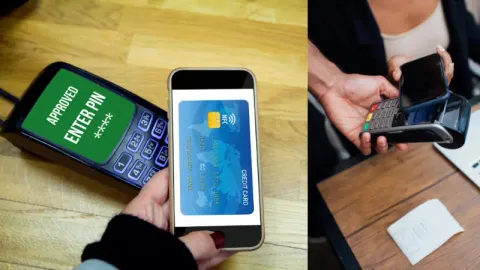
Getting started with NFC payments is simple. These steps will help any retailer, service provider, or venue accept contactless transactions with ease.
Step 1 – Pick the Right Payment Platform
Choose a payment processor that supports NFC. Square, Stripe, Clover, and Shopify POS are solid options for most businesses. Make sure the one you select integrates smoothly with your current checkout flow and offers reliable support for mobile wallet transactions.
Step 2 – Get NFC-Enabled Hardware
Equip your checkout area with hardware that supports tap-to-pay.
You can choose:
- A POS system with built-in NFC
- A portable NFC reader that pairs with a smartphone or tablet
You don’t always need a full hardware overhaul—some mobile readers are plug-and-play.
Step 3 – Prepare Your Staff and Customers
Train your team to recognize NFC-capable devices and assist customers during checkout.
Use simple signage to show that you accept Apple Pay, Google Pay, and other wallets.
Prompts like “Tap here to pay” or “Contactless payments available” help guide customer behavior naturally.
Step 4 – Test and Secure Your Setup
Run a few test transactions to confirm everything works.
Check that the NFC reader responds instantly and processes payments without delay.
To protect your business and customers, follow the best practices:
- Enable tokenization and biometric checks
- Keep device software up to date
- Monitor for any irregular activity
A secure, smooth experience builds trust and repeat business.
FAQs About NFC Mobile Payments
Are NFC payments secure?
Yes. NFC payments use tokenization, which means your actual card number is never shared. Most devices also require a fingerprint, face ID, or a passcode to authorize a transaction.
Do I need the internet to make NFC payments?
No. NFC payments don’t need a live internet connection to send payment data. However, your bank or card issuer may require a connection to approve the transaction, depending on your setup.
How do I know if my phone supports NFC?
Check your phone settings. On Android, go to “Connection Preferences” or “Wireless & Networks.” On iPhones (models 6 and above), NFC is built in and works automatically with Apple Pay.
Do all POS systems accept NFC?
Not all. Older POS systems often lack built-in NFC hardware. Businesses need an NFC-capable terminal or a mobile card reader that supports contactless payments.
Can small businesses accept NFC without full POS systems?
Yes. You can use mobile readers from providers like Square or Stripe. These plug into a smartphone or tablet and allow secure tap-to-pay transactions without major hardware.
What is the range of an NFC payment tap?
NFC only works within about 4 cm. That short range helps reduce interference and adds a layer of security against unauthorized scanning.
Final Thoughts: NFC is the Future of Contactless Transactions
NFC is how your customers already expect to interact. Every tap signals speed, trust, and tech-readiness. If your checkout still relies on cards or cash, you’re not just slowing things down…you’re falling behind.
NFC systems aren’t complex or expensive anymore. They’re simple to set up, easy to use, and built for businesses of every size.
Ready to upgrade your checkout experience?
Streamline payments and boost customer satisfaction with our tailored NFC POS systems. Perfect for your business needs—fast, secure, and hassle-free.
Explore More…Get in Touch, and let’s transform your checkout process today!

